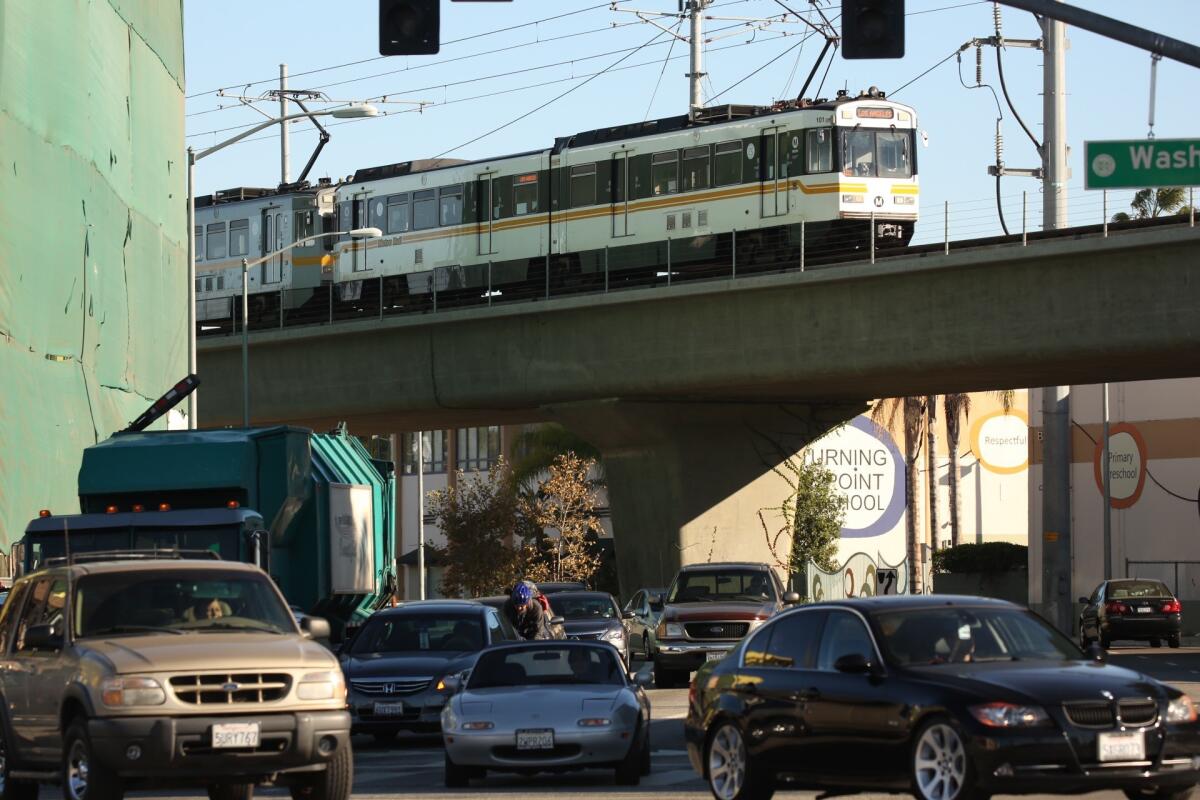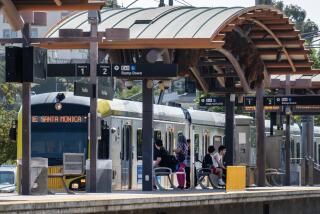Billions spent, but fewer people are using public transportation in Southern California

Metro plans to spend more than $12 billion over the next 10 years to build two new rail lines and three extensions, the largest capital investment of any transit agency in the country.
For almost a decade, transit ridership has declined across Southern California despite enormous and costly efforts by top transportation officials to entice people out of their cars and onto buses and trains.
The Los Angeles County Metropolitan Transportation Authority, the region’s largest carrier, lost more than 10% of its boardings from 2006 to 2015, a decline that appears to be accelerating. Despite a $9-billion investment in new light rail and subway lines, Metro now has fewer boardings than it did three decades ago, when buses were the county’s only transit option.
Most other agencies fare no better. In Orange County, bus ridership plummeted 30% in the last seven years, while some smaller bus operators across the region have experienced declines approaching 25%. In the last two years alone, a Metro study found that 16 transit providers in Los Angeles County saw average quarterly declines of 4% to 5%.
Do you take public transit? Why or why not? Join the conversation on Facebook >>
Years after the end of the worst recession since World War II, which prompted deep service cuts, transit agencies are still trying to figure out where their riders have gone and what can be done to bring them back, including major changes to routes and schedules.
Officials say ridership is cyclical and customers will return as traffic congestion worsens, bus service improves, new rail lines open and more of the region’s population moves to walkable neighborhoods near transit stops.
But some experts say the downturn could represent a permanent shift in how people get around, propelled by a changing job market, falling gas prices, fare increases, declining immigration and the growing popularity of other transportation options, including bicycling and ride-hailing companies such as Uber and Lyft.
“I don’t know if this is long-term, but it doesn’t feel like it’s temporary when we’ve been dealing with 36 straight months of declining ridership,” said Darrell Johnson, chief executive of the Orange County Transportation Authority.
The decline suggests that Southern California policymakers are falling short of one of their longtime goals: drawing drivers out of their cars and onto public transportation to reduce traffic congestion, greenhouse gases and the region’s reliance on fossil fuels.
Southern California certainly isn’t alone. Public transportation use in many U.S. cities, including Chicago and Washington, D.C., has slumped in the last few years. But the question takes on new significance in Los Angeles County, where politicians and transportation officials are considering whether to seek another half-cent sales tax increase in November that could raise $120 billion for major transportation projects, including several new rail lines.
“It’s a bit perverse,” said USC engineering professor James E. Moore II, who has been a critic of rail transit. “You’re spending all this money and you’re driving ridership down. If you’re investing heavily in transit, you’d hope ridership would increase.”
Phil Washington, Metro’s chief executive, says the slump will reverse when his agency finishes a “complete buildout” of its growing rail network, a process that could take decades.
Metro plans to spend more than $12 billion over the next 10 years to build two new rail lines and three extensions, the largest capital investment of any transit agency in the country.
In addition, the Los Angeles City Council approved a sweeping plan last fall to encourage the use of transit and alternative forms of transportation. Mobility Plan 2035 calls for hundreds of miles of bike and bus-only lanes to be added to city streets over the next two decades.
“We’re not building for today,” Washington said. “We’re building for 100 years down the road.”
Although buses account for about 75% of Metro’s ridership, rail operations and construction receive more money than buses do from Measure R, the county’s most recent half-cent sales tax to fund transportation projects.
Metro has worked to speed up some bus routes, including giving buses their own lanes during rush hour on Wilshire Boulevard, the most traveled corridor in the county. The majority of buses, however, crawl through the streets at rush hour, and passengers often complain about long travel times.
“There’s been lots of focus by transit agencies on shiny new things, sometimes at the expense of bus routes which serve the primary constituencies of transit agencies: low-wage workers,” said Brian Taylor, the director of UCLA’s Institute of Transportation Studies. “Lots of resources are being put into a few high-profile lines that often carry a smaller number of riders compared to bus routes.”
John Durant, 36, stopped taking Metro buses after he graduated from Cal State L.A., where his daily transit commute was 45 minutes each way. After he got a job in downtown Los Angeles, Durant bought a car, even though parking, insurance and gas cost him hundreds of dollars more per month than his Metro pass.
“If taking the bus were faster than driving, more people would do it,” Durant said. “But it isn’t.”
Thirty years ago, Metro’s predecessor, the Southern California Rapid Transit District, handled almost 500 million annual bus boardings in Los Angeles County. In the decade that followed, the transit district and then Metro raised fares and cut bus service hours to fund an aggressive construction program for a subway through downtown Los Angeles and light-rail lines to Long Beach and between Norwalk and Redondo Beach.
In 1994, an organization that represented bus riders sued Metro in federal court, alleging that cutting bus service to pay for new rail lines discriminated against minority passengers who faced increasingly crowded buses. In a landmark settlement, Metro agreed to stop raising fares for 10 years and relieve overcrowding by adding more than 1 million hours of bus service.
Ridership soared. Metro buses and trains recorded about 492 million boardings in 2006, the most since 1985. But from 2009 to 2011, several years after federal oversight ended and during the Great Recession, the agency raised fares and cut bus service by 900,000 hours.
By the end of 2015, ridership had fallen 10% from 2006, with the steepest declines coming in the last two years.
The numbers look even grimmer in Orange County, where the transportation authority saw a 30% decline in boardings between 2008 and 2014, from 68.9 million to 48.1 million. In the first 11 months of 2015, the most recent data available, ridership fell by an additional 2.4 million.
Although Orange County’s economy has rebounded, the types of jobs typically held by transit riders may have changed, both in quality and quantity, OCTA officials say. In 2007, more than half of bus riders said they had full-time work. That dropped to 37% in 2014, according to OCTA, and those who had part-time jobs grew five percentage points over the same period.
“Our ridership usually has tracked along with improving employment levels,” Johnson, the agency’s chief executive, said, “but not this time.”
OCTA has plans to overhaul bus service by providing faster and more frequent service in areas of high demand and cutting service on the less-used lines, possibly replacing them with shuttles, vans and trolleys.
Also under consideration are lower fares and tech-friendly improvements, including mobile ticketing and real-time information for riders. Officials predict that the plan will increase annual ridership by 1.6 million boardings within three years.
Metro is weighing a partnership with ride-hailing companies such as Uber and Lyft, saying their drivers could bridge the so-called “first mile, last mile” gap between a commuter’s transit stop and their destination. Agency staff say they suspect rides in those for-hire vehicles may be replacing some transit trips.
The L.A. Department of Transportation’s DASH and Commuter Express buses have also been hit hard. They lost 19% of their boardings between 2008 and 2014 after the agency cut routes and doubled its 25-cent fare.
“Less people are riding, period,” said Corinne Ralph, LADOT’s head of transit operations. When the department met with Metro and other local transit agencies in December to discuss the ridership downturn, she said, it seemed to be “a major surprise to most transit operators.... No one really anticipated the severity of the decline.”
According to census data, up to 7% of Los Angeles County residents commute using transit while a lower percentage do so in surrounding counties. Metro’s goal is to convert 20% to 25% of the county’s population into regular transit riders, Washington said.
Doing so would require tapping into the vast groups of riders who can afford to drive. Currently, a Metro rider’s median household income is $15,918 — far below the countywide median of $55,909.
About 20% rely on public transportation to commute to work during the first five years they live in California, including L.A. County, according to Evelyn Blumenberg, the chairwoman of UCLA’s urban planning department.
The longer immigrants live in the U.S., the less likely they are to take the bus or train, either because they begin to drive or move to suburbs with less transit service. After two decades in the United States, about 6% of immigrants ride transit, only slightly higher than native-born residents, Blumenberg said.
After a surge in immigration in the 1980s, which significantly bolstered bus and rail ridership, the influx of foreign-born people peaked in California in 1991 and has been declining since, she said.
A new avenue for driving also might have opened up for immigrants who are in the country illegally. A law that took effect last year allows them to obtain California driver’s licenses. So far, the Department of Motor Vehicles has issued more than 605,000 such licenses, a spokesman said.
In addition, some transit officials say the recovering economy has helped transit riders find at least partial access to cars. During the last five years, the number of former OCTA bus riders who gained access to cars almost doubled, agency surveys show.
“It’s not the dream of every bus rider to arrive in a bus that was on time, air conditioned and clean, where a seat was available,” said Moore of USC. “It’s the dream of every bus rider to own a car. And as soon as they can afford one, that’s the first purchase they’ll make.”
According to the Southern California Assn. of Governments, the total number of miles driven in the region per day has almost returned to pre-recession levels, although the miles driven daily per person are declining.
Still other former riders have voiced concerns about safety and a lack of convenient service.
Suzan Mikiel moved from New York five years ago to Los Feliz, which has a Red Line subway stop. She took transit for four years as she auditioned for acting roles and worked temporary jobs as a caterer, a photographer and a writer’s assistant.
Transit offered a chance to relax, people-watch or take photos during the day, she said. But at night, trying to get home was sometimes “horrible, if not impossible.”
Mikiel occasionally found herself stranded in unfamiliar neighborhoods late at night. On less-traveled routes, connecting to another bus could take an hour. Finally, after being robbed near the Culver City Expo Line station, she bought a car.
“Driving has really opened up my experiences in L.A.,” Mikiel said. “I love my car. I’m keeping it.”
[email protected] | Twitter: @laura_nelson
[email protected] | Twitter: @LAdeadline16
ALSO
Negligence by Southern California Gas Co. led to massive Porter Ranch-area gas leak, AQMD says
L.A. is working to count a hidden population — homeless young people
New details emerge from O.C. jail break; sheriff ‘extremely troubled’
More to Read
Sign up for Essential California
The most important California stories and recommendations in your inbox every morning.
You may occasionally receive promotional content from the Los Angeles Times.












